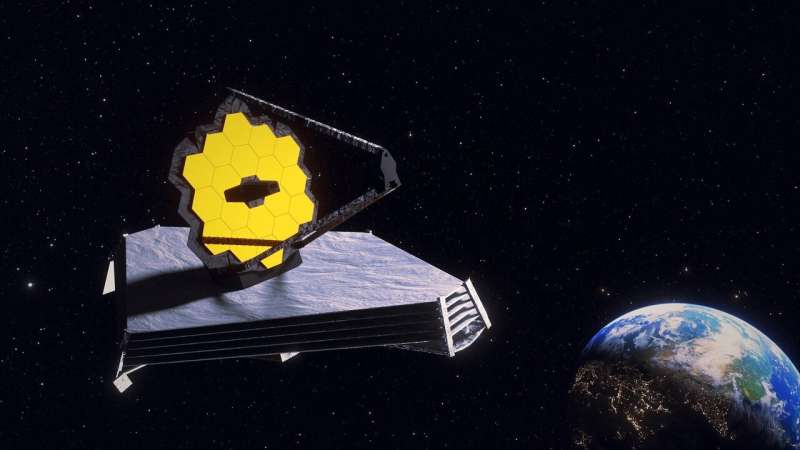"
"There will definitely be the deepest field we've ever seen. There will be our first glimpse at what an exoplanet atmosphere looks like with Webb," Mullally said. "And there will be other images—I think—that will just simply take your breath away."
The National Aeronautics and Space Administration is holding an official unveiling at the Goddard Space Flight Center about 30 miles south of Baltimore in Greenbelt, where much of the telescope was assembled.
But Baltimore is the telescope's earthbound home base, where technicians have carefully monitored the spacecraft since its launch last year.
The images promise to be spectacular, not least because the images that have already come from Webb—snapshots taken during calibration—wowed astronomers. Filled with backgrounds of swirling galaxies, the early images showed off Webb's ability to peer deep into space, and therefore back in time. Using infrared technology, Webb will be able to cast its eyes to 100 million to 250 million years after the Big Bang, providing a new gaze upon the early universe.
It's been a long time coming. Construction on the roughly $10 billion telescope officially began in 2004, following years of planning kicked off by a workshop at Baltimore's institute in September 1989. Over the years, unexpected complications ballooned the project's cost and steadily pushed back its launch date, until Christmas Day last year, when it was sent skyward from South America.
Choosing which observations to highlight after so many years of work was far from simple, Mullally said.
"It was a lot of astronomers sitting in the room going: 'That really highlights this part of astronomy, but that really shows off this bit,'" she said. "And so, how do you get to the best image that allows you to tell that scientific story that you really want people to understand?"
Crafting the images is also something of a subjective process. Artists at the institute must essentially assign color to black and white images as scientifically as possible, creating visual representations of wavelengths of light that humans cannot see.
A few days after the images are released, a roughly 50-terabyte trove of the telescope's data will hit a public archive, Mullally said. That's mainly for interested astronomers, giving them a window into the telescope's first few months in the cosmos. The data, collected while the telescope's instruments were calibrated, could be fodder for future investigations, and help scientists outside the mission better understand the way it works.
For astronomers such as Eliza Kempton, an associate professor of astronomy at the University of Maryland, the arrival of information from Webb is a career-defining moment.
Kempton has been studying a specific exoplanet, called GJ1214b, ever since it was discovered in 2009. Though it is just 40 light-years from Earth, certain details about the planet remain a mystery, including the makeup of its atmosphere, since it is surrounded by a thick layer of haze. Efforts to observe it with the Hubble and Spitzer space telescopes, and from telescopes on the ground, haven't solved the puzzle. But Webb promises to.
"We really exhausted our options," Kempton said. "And so JWST is the thing that we've been waiting for this whole time."
The details about GJ1214b, captured using Webb's novel mid-infrared instrument, will allow astronomers to infer characteristics about other sub-Neptune exoplanets, so named because they are larger than Earth but smaller than Neptune. They are among the most commonly occurring type of planet, but our solar system doesn't contain one, Kempton said.
Kempton is among the lucky group of scientists whose requests for observation time have been approved, and hers is coming up quickly. It's planned for the end of July.
"It's very exciting, and I'm sure that we will be a little bit perplexed. I'm sure that whatever we do see will be somewhat surprising," she said. "It's just a few weeks away, so I kind of wake up in the morning and I'm trying not to get too anxious about the fact that this is coming so soon, and we don't really know what we're going to see."
Webb's first year or so of scientific programs has been decided, and schedulers are packing in a constant stream of observations, keeping in mind that certain celestial phenomena scientists want to view are visible only at particular times. It's a balancing act, with the aim of ensuring few precious minutes in the telescope's life span, limited by its fuel storage and its ability to withstand the harsh conditions of space, are not wasted. But with so much on the horizon, it seems clear that Tuesday will simply be Webb's first impression on our imagination of the cosmos.
"It's going to be the start of something wonderful," Mullally said.
Explore further
2022 The Baltimore Sun.
Distributed by Tribune Content Agency, LLC.



